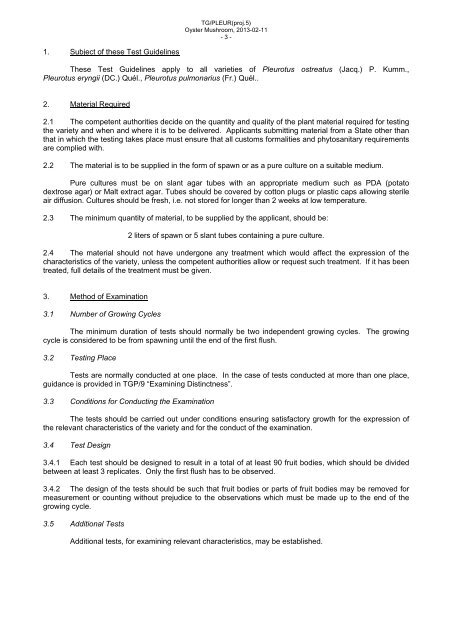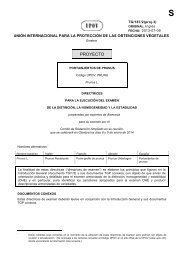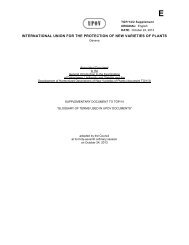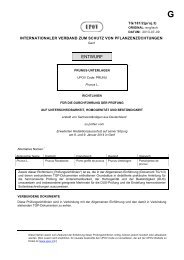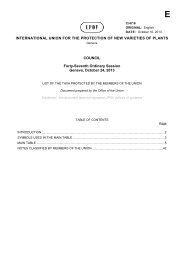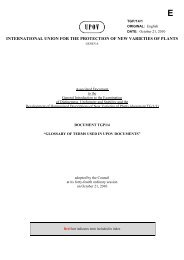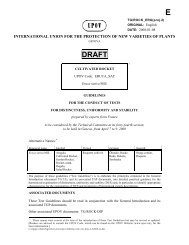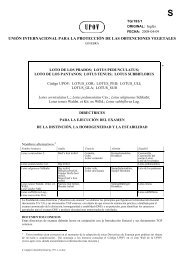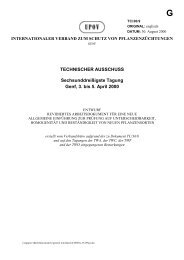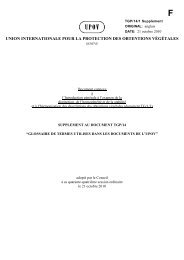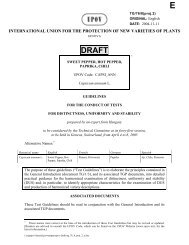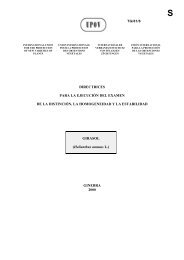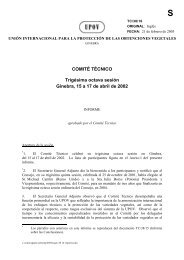(Pleurotus ostreatus (Jacq.) P. Kumm.) - International Union for the ...
(Pleurotus ostreatus (Jacq.) P. Kumm.) - International Union for the ...
(Pleurotus ostreatus (Jacq.) P. Kumm.) - International Union for the ...
You also want an ePaper? Increase the reach of your titles
YUMPU automatically turns print PDFs into web optimized ePapers that Google loves.
TG/PLEUR(proj.5)<br />
Oyster Mushroom, 2013-02-11<br />
- 3 -<br />
1. Subject of <strong>the</strong>se Test Guidelines<br />
These Test Guidelines apply to all varieties of <strong>Pleurotus</strong> <strong>ostreatus</strong> (<strong>Jacq</strong>.) P. <strong>Kumm</strong>.,<br />
<strong>Pleurotus</strong> eryngii (DC.) Quél., <strong>Pleurotus</strong> pulmonarius (Fr.) Quél..<br />
2. Material Required<br />
2.1 The competent authorities decide on <strong>the</strong> quantity and quality of <strong>the</strong> plant material required <strong>for</strong> testing<br />
<strong>the</strong> variety and when and where it is to be delivered. Applicants submitting material from a State o<strong>the</strong>r than<br />
that in which <strong>the</strong> testing takes place must ensure that all customs <strong>for</strong>malities and phytosanitary requirements<br />
are complied with.<br />
2.2 The material is to be supplied in <strong>the</strong> <strong>for</strong>m of spawn or as a pure culture on a suitable medium.<br />
Pure cultures must be on slant agar tubes with an appropriate medium such as PDA (potato<br />
dextrose agar) or Malt extract agar. Tubes should be covered by cotton plugs or plastic caps allowing sterile<br />
air diffusion. Cultures should be fresh, i.e. not stored <strong>for</strong> longer than 2 weeks at low temperature.<br />
2.3 The minimum quantity of material, to be supplied by <strong>the</strong> applicant, should be:<br />
2 liters of spawn or 5 slant tubes containing a pure culture.<br />
2.4 The material should not have undergone any treatment which would affect <strong>the</strong> expression of <strong>the</strong><br />
characteristics of <strong>the</strong> variety, unless <strong>the</strong> competent authorities allow or request such treatment. If it has been<br />
treated, full details of <strong>the</strong> treatment must be given.<br />
3. Method of Examination<br />
3.1 Number of Growing Cycles<br />
The minimum duration of tests should normally be two independent growing cycles. The growing<br />
cycle is considered to be from spawning until <strong>the</strong> end of <strong>the</strong> first flush.<br />
3.2 Testing Place<br />
Tests are normally conducted at one place. In <strong>the</strong> case of tests conducted at more than one place,<br />
guidance is provided in TGP/9 “Examining Distinctness”.<br />
3.3 Conditions <strong>for</strong> Conducting <strong>the</strong> Examination<br />
The tests should be carried out under conditions ensuring satisfactory growth <strong>for</strong> <strong>the</strong> expression of<br />
<strong>the</strong> relevant characteristics of <strong>the</strong> variety and <strong>for</strong> <strong>the</strong> conduct of <strong>the</strong> examination.<br />
3.4 Test Design<br />
3.4.1 Each test should be designed to result in a total of at least 90 fruit bodies, which should be divided<br />
between at least 3 replicates. Only <strong>the</strong> first flush has to be observed.<br />
3.4.2 The design of <strong>the</strong> tests should be such that fruit bodies or parts of fruit bodies may be removed <strong>for</strong><br />
measurement or counting without prejudice to <strong>the</strong> observations which must be made up to <strong>the</strong> end of <strong>the</strong><br />
growing cycle.<br />
3.5 Additional Tests<br />
Additional tests, <strong>for</strong> examining relevant characteristics, may be established.


